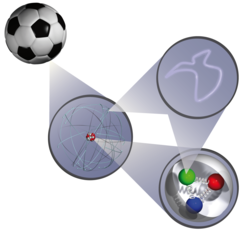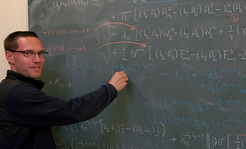Popular talk: String theory - a red thread through natural phenomena
Dr. Oliver Schlotterer (Max Planck Institute for Gravitational Physics in Potsdam) will give a public lecture at the "Potsdamer Köpfe im Kiez" on February 26th, 2014.
Time: 6pm
Location: Friedrich Reinsch House at Milanhorst 9, 14478 Potsdam

Natural phenomena from intergalactic to subatomic scales are accurately described by Einstein's General Theory of Relativity and the Standard Model of Particle Physics. The theory of relativity is needed to describe large masses at the largest possible distances, as we find them in space: Neutron stars and supernovae are examples of such phenomena. The quantum mechanics on which the Standard Model is based covers the special features on small length scales as long as the masses involved remain small. A classic example of this is the processes that are studied in particle accelerators like CERN.
However, if one wants to describe a phenomenon such as the Big Bang, the two separate theories reach the limits of their applicability, since according to the current Big Bang model, huge masses are concentrated on a minutely small volume. To understand the Big Bang, we need a unified theory that describes the processes on both the very large and the very small length and mass scales. However, it has not yet been possible to establish a theory that describes the entire natural process. Even Albert Einstein himself was not happy with this situation and searched for a unified theory until his death - but in vain. In any case, one thing is clear: the search for a superordinate "theory of everything" that describes both astronomical processes and those in the regime of quarks & co. requires a radical rethink.
In the lecture, Oliver Schlotterer will explain how string theory offers a unifying view of the fundamental forces of nature. Both gravity and electromagnetic and (sub)atomic interactions are described as a dance of vibrating strings. This raises the question of further, hitherto unobserved spatial dimensions that can provide a geometric explanation for some phenomena. In his lecture, Oliver Schlotterer will give a vivid impression of central aspects of string theory.

Dr. Oliver Schlotterer
studied physics and mathematics in Tübingen, Konstanz and Cambridge. After his diploma thesis at the ETH Zurich (2008) he received his doctorate in 2011 at the Max Planck Institute for Physics (Werner Heisenberg Institute) in Munich. He then held postdoctoral positions at the Max Planck Institute for Gravitational Physics (Albert Einstein Institute) in Potsdam and the Department of Applied Mathematics and Theoretical Physics in Cambridge. Since 2013 he is a research associate at the Max Planck Institute for Gravitational Physics (Albert Einstein Institute) in Potsdam. Since his doctoral thesis he has been researching string theory.













